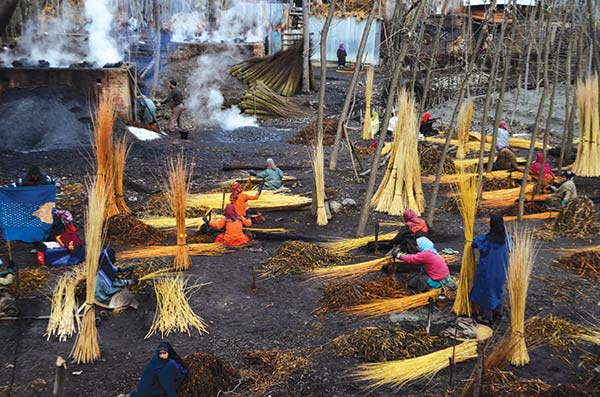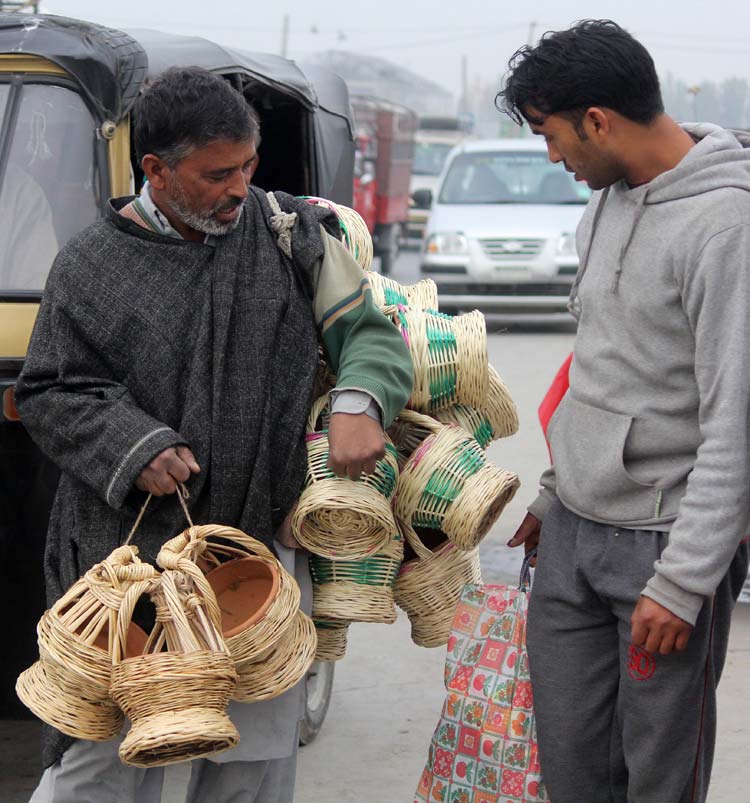by Syed Batool Andrabi
SRINAGAR: The traditional Kangri, a portable fire pot, serves as a vital source of warmth during the harsh winter months in Kashmir, where temperatures can plummet to as low as minus 14 degrees C. Encased in handmade wicker baskets, this pot contains glowing embers and is conveniently carried within the folds of the pheran, a long woollen cloak worn by the locals.
The manufacturing of the Kangri involves a blend of skilled labour and local artisanal craftsmanship. Despite the prevalence of modern electronic heating devices, the Kangri remains a cost-effective and efficient heating solution, particularly in areas where electricity may be scarce or during periods of load-shedding.
The Kangri, with its eco-friendly design, continues to be in high demand across Kashmir. Notably, it has now found its way to the local markets of Jammu, marking a notable shift.
The renowned Raghunath Bazar in Jammu City is currently a hub for the sale of these traditional Kashmiri fire-pots.

Residents attribute the surge in Kangri purchases in Jammu to a recorded temperature dip. According to Vickey, a shopkeeper at Raghunath Bazar, individuals from various walks of life are drawn to this attractive and economical heating option. The Kangri, once a staple solely in Kashmir, now resonates beyond its traditional boundaries, becoming a sought-after commodity in the markets of Jammu.
According to Vickey, a local shopkeeper, the demand for Kangris in Jammu’s bustling markets is a recent phenomenon.
“I have known about Kangris since childhood but never used one until recently. It’s become something of an addiction. Ever since my mother introduced me to it, I’ve been placing a Kangri in my bed every night, and the warmth is incredibly comforting,” said Ajay, a Kashmiri Pandit.
Despite concerns from his parents, Ajay persists in using the Kangri in bed. Speaking to a buyer in the city market, Fozia, originally from Kishtwar, said, “We come from a cold region, but we don’t make such arrangements at our place. We move to Jammu every winter to escape the chilly Kishtwar weather. This year, with Jammu experiencing its lowest temperature, Kangris have become a saviour for people like us.”

Fozia, trying a Kangri for the first time, explained, “My friend suggested I buy one from here. Jammu usually has milder winters compared to our place, but this time, the weather conditions prompted the need for something to keep us warm.”
Amit Gupta, a local resident, shared his experience, saying, “I saw Kangris in the city market last time, and it took me less than a minute to decide to buy one. The shopkeeper advised me to light it and place it under a blanket for added warmth. My wife and I tried it, and it worked like magic. Now, I’m here again to buy a new Kangri for her.”
Kangri vendors also said that the current weather has boosted Kangri sales. “These Kangris are brought here and marketed by Kashmiris. We purchase them from Kashmir and sell them in the city markets,” they said.
In Jammu, where the use of kangris has traditionally been associated with Kashmiris, there’s a noteworthy surge in demand among Jammu residents, prompting local shops to stock up on these traditional fire-pots.
Mukeet, a Kangri seller, reports selling more than 10 Kangris daily. Despite the prevalence of modern technology, Kangris maintain a market presence and serve as a source of livelihood for many engaged in the trade.
Beyond their utilitarian function, Kangris have gained popularity as a cultural phenomenon in Jammu. People from distant locations are now drawn to purchase Kangris, and these traditional fire-pots are increasingly exchanged as gifts.
Rakesh Wantoo, a Janipur resident, emphasized the unique significance of Kangris in combating the harsh cold, asserting that even with advanced heating options, Kangris remain irreplaceable. He pointed out their enduring importance, especially during electricity shortages in severe winters.
Speaking with a wholesaler, Bilal Ahmed mentioned, “Observing shifts in Jammu’s weather, we began taking orders for Kangris from local markets, notably the city market. The demand has exceeded our expectations. I dispatched a truck full of Kangris to Jammu 15 days ago, and every unit has been sold. Shopkeepers are placing additional orders as the business thrives.”
Pummy Sharma, while shopping at the city market, expressed her fascination with the beautiful Kangris on display. Guided by the shopkeeper, Valai Bhaya, she intends to try making one at home by following the instructions. “I’m excited to try Kangri. I’ll go home and start the process, hoping all goes well. It’s all about fire,” she remarked.
Ilyas, a Kashmiri resident in Jammu, shared that his friend from Jammu recently purchased a Kangri and sought guidance on how to use it, highlighting the growing interest in traditional fire-pots in the region.
The northern plains of India, including Jammu, are presently experiencing multiple cold waves. Recent weather reports indicate a temperature range in Jammu over the past week, with the highest recorded at 12 degrees Celsius on December 31, 2023, at 2:30 PM, and the lowest at 2 degrees Celsius on January 11, 2024, at 11:30 PM. The average temperature during this period stood at 8 degrees Celsius. Humidity levels fluctuated from 100% on December 31 at 9:00 PM to 87 per cent on January 3 at 7:30 PM.
During the Chillai-Kalan, the coldest period of winter, there has been an unexpected turn of events, with temperatures reaching a notable maximum of 15.0 degrees Celsius—the warmest day in 14 years.
The post 2024 Winter Sees Massive Kangri Demand in Jammu appeared first on Kashmir Life.
from Kashmir Life https://ift.tt/HDhPwjJ
via IFTTThttps://ift.tt/fKhuVGL
No comments:
Post a Comment